The sun provides us with warmth, light, and abundant, clean energy. Thanks to modern innovations, we can harness this energy to power various devices, cars, public transport, and more. Moreover, utilizing the sun’s abundant energy has the potential to reduce climate change.
This eco-friendly power source rapidly transforms our world, offering a sustainable future. But how exactly can solar energy mitigate all those climate fluctuations? Check this article to discover the economic and environmental impact of solar energy.
History of Climate Change: A Glimpse Backwards
Earth’s climate is constantly fluctuating. While many people think the closest cold period was a million years ago, they forget about the “Little Ice Age” during the Renaissance and early Victorian era. It’s not the classic “ice age,” but more like a few relatively cold centuries.
However, in the late 19th century, a significant shift occurred. The Industrial Revolution accelerated the once gradual natural warming process to the extent that climate zones could change within a person’s lifetime.
Mild climate zones have progressively transitioned towards subtropical conditions, experiencing minimal snowfall for extended periods. It raised concerns about the human impact on our environment and prompted questions about how to prevent climate change.
The global temperature has risen by about 1°C (1.8°F) since the late XIXth century. This heat melts the icebergs on the North and South poles, leading to rising sea levels. If global warming stays at the same level, Houston and New Orleans may partially sink before 2100. That’s why many scientists have environmental concerns and try their best to reduce climate change.
In the middle of the XX century, research like the Keeling Curve solidified the link between human activity and CO2 levels in the atmosphere. In the 70s, climate fluctuations concerns became the source of public discussion, like the Intergovernmental Panel on Climate Change (IPCC) in 1988. Their main aim is to reduce climate change worldwide.
Why Is Solar Energy Good for the Environment And How It Can Reduce Climate Change
As of now, it’s impossible to stop global warming immediately. However, we can still slow its pace, making it bearable for future generations. Here is how we can prevent climate change from going further:
| Lower emissions | Unlike fossil fuels that release substantial amounts of carbon dioxide, renewable energy sources generate electricity with little to no emissions. The positive environmental impact of solar energy is higher than in other eco-friendly alternatives, such as hydroelectric stations. |
| Reduced reliance on non-renewable power sources | As renewable energy adoption increases, the reliance on fossil fuels decreases. This shift in energy dependence leads to a decline in greenhouse gas emissions. It can possibly reduce climate change. |
| Improved air quality | Fossil fuel is one of the largest contributors to air pollution. Renewable energy sources generate minimal to no harmful air pollutants, improving air quality and lowering public health risks. |
| Sustainable resource management | Solar and wind power are continuously replenished by natural processes. It ensures sustainability and avoids the issue of depleting finite resources like fossil fuels. |
Renewable energy solutions are one of the answers to the question, “How to reduce climate change in less than one generation?”. By understanding its multifaceted impact and the need for a holistic approach, we can collectively take action towards a healthier planet.
Environmental Impact of Solar Energy on Climate Shift Reduction
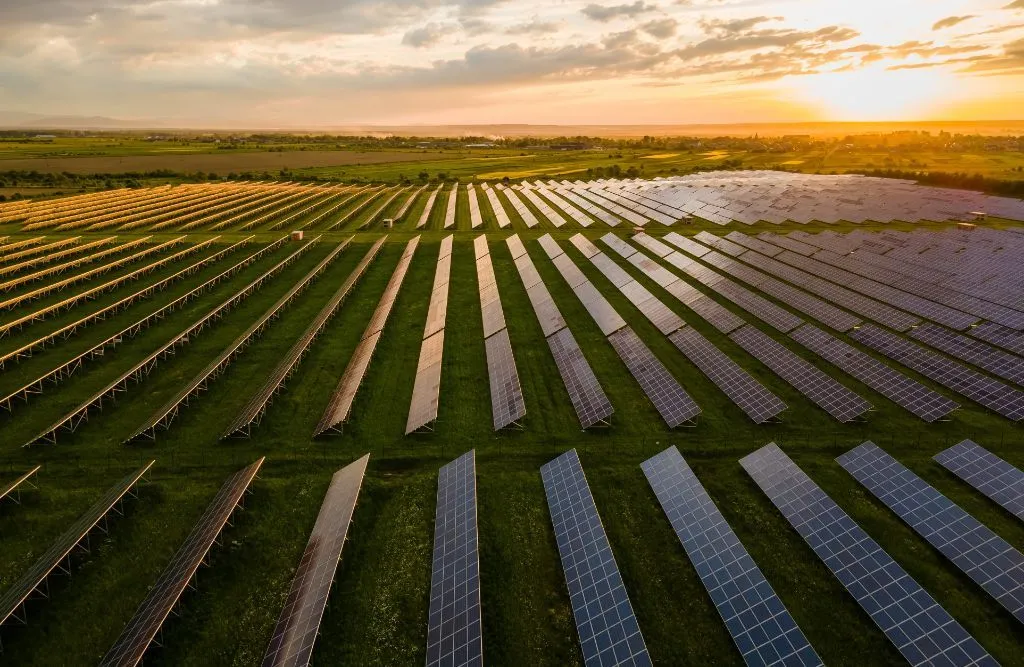
Solar power production has become widespread across industrial, commercial, and residential sectors. Just two decades ago, the cost of a solar system for an average household exceeded $30,000. During that period, there were no government incentives to make the transition to solar more cost-effective. That’s why people and businesses weren’t interested in purchasing panels back then, despite the environmental impact of solar energy.
Meanwhile, the average cost of modern solar panels ranges from $10,000 to $25,000. It’s a noticeable price reduction, while solar tax credits and other government incentives can make the system even more affordable. Combined with eco-friendly perks, solar panels have become a solid alternative to traditional power generation methods. In the long run, it can reduce climate change in a few generations.
Today, even the average household solar system can produce enough energy to power the whole house and multiple electric cars. Some highly efficient panels may produce so much energy that the owner can sell the excessive power to the grid. Considering the environmental impact of solar energy, switching to eco-friendly power production can benefit both the panel owner and the local community.
Solar panels help climate change by reducing carbon dioxide emissions:
- When you generate 100kWh of energy using solar panels, you can save over 1,400 pounds of carbon output.
- An average solar panel can reduce over 200,000 pounds of CO2 emissions during its lifetime (25-30 years).
It will slowly but surely reduce climate change, at least on the local level. Solar-powered communities will have a clearer air than fossil-powered communities, attracting even more people to create similar groups, villages, and cities.
These neighborhoods can collaborate to build community solar farms to boost the environmental impact of solar energy in their area. In this case, people don’t need to put solar panels onto roofs. They don’t even need to make a huge initial payment, as the solar farm signs the contract with the neighborhood to become their power provider.
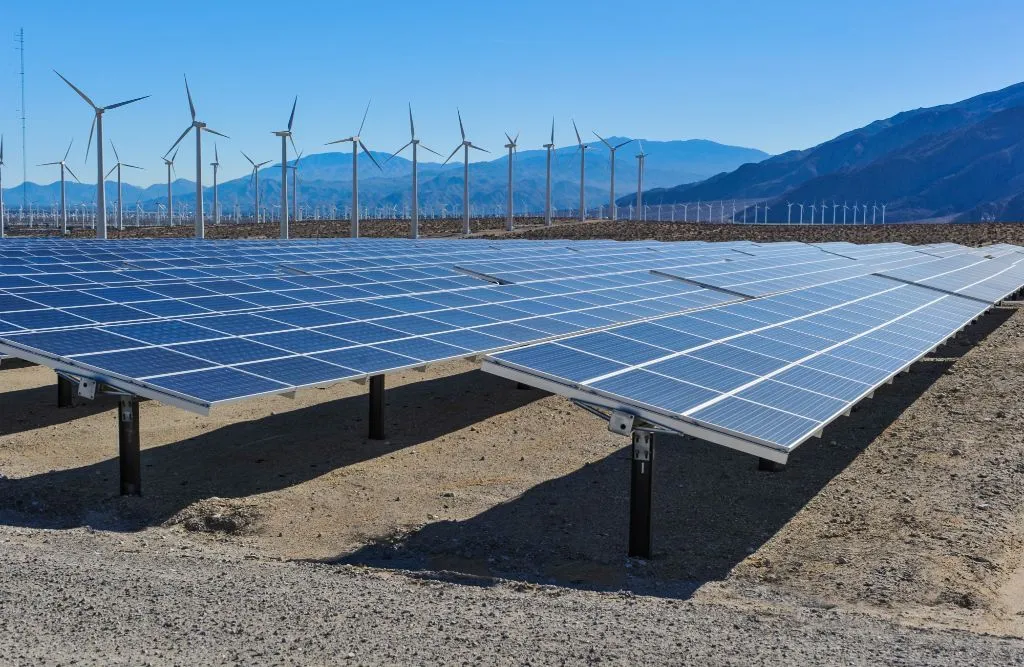
The solar industry creates new jobs, lowering the unemployment rate in those eco-friendly communities. All these efforts, combined, will reduce climate change on the local level, positively affecting state and worldwide life quality.
Solar Energy’s Role in the Electric Sector
Solar systems generate electricity directly from sunlight, feeding it into the grid. This clean energy displaces electricity from traditional fossil fuel sources, lowering greenhouse gas emissions and air pollution. Those decisions also slowly reduce climate change, as fewer people rely on non-renewable power sources.
However, solar energy is a variable resource. It means that its output fluctuates depending on sunlight availability. That’s why everyone who decides to use solar panels should have a backup plan for cloudy winter days. You should pick the most eco-friendly method for your case to maintain the positive environmental impact of solar energy.
The increasing presence of solar in the electricity mix fosters competition in the energy market, potentially leading to lower consumer electricity prices. New business models like community solar and virtual power plants will allow broader participation in clean energy generation.
Solar Power and the Transportation Sector
The transportation industry is one of the largest contributors to climate change, producing tons of greenhouse gas emissions. Solar energy, with its clean and abundant nature, presents exciting possibilities for decarbonizing various aspects of conveyance. The environmental impact of solar energy in the transportation sector is limitless.
You can use solar energy to power electric vehicles. While a solar car roof is still a dream, you can already charge the car using energy generated on panels installed on your house’s roof. It can reduce climate change in your household, as you get eco-friendly electricity for your car.
Here are some examples of the environmental impact of solar energy on urban sustainability:
- Cities can use solar farms to power streetcars and trolley grids.
- Local bus depots can switch to electric buses and install panels on depot’s roof to charge their vehicles.
- Municipal authorities can place solar panels on bus stops to power lights, ticketing systems, or even feed back to the grid.
- Replacing gasoline and diesel vehicles with solar-powered alternatives lowers greenhouse gas emissions and air pollution. It contributes to cleaner air and improved public health.
That’s how an eco-friendly approach to the transportation sector can reduce climate change on municipal and state levels.
Solar Energy and the Industrial Sector
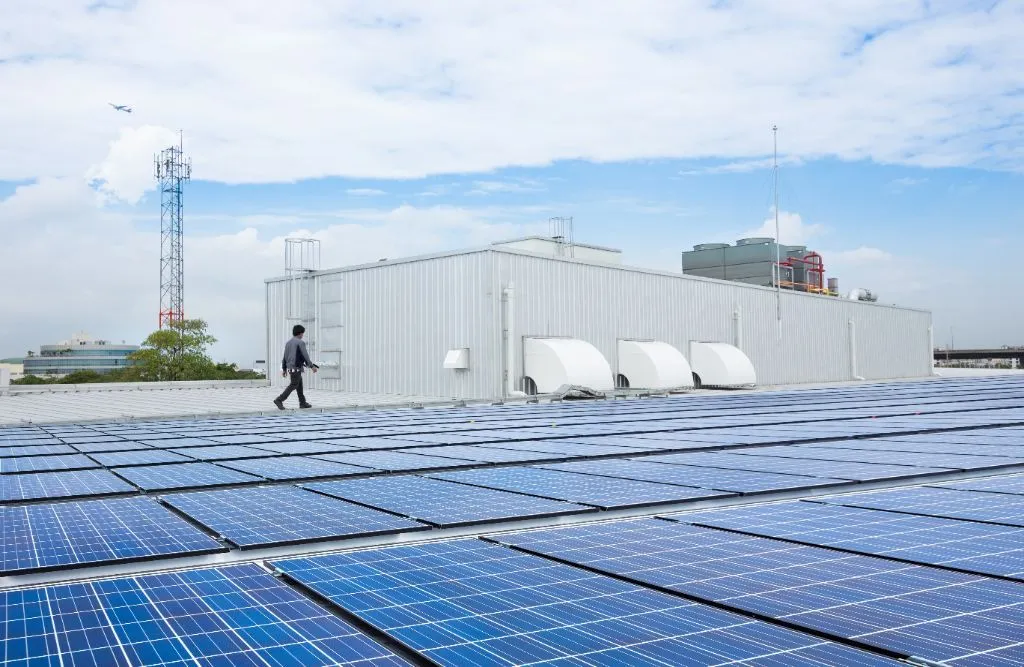
The industrial sector, the most significant electricity consumer, calls for eco-friendly energy production. While certain industries continue to require the significant power output currently provided solely by fossil fuels, there are many cases where solar energy has the potential to replace old methods and reduce climate change.
Small and middle-sized manufacturers can install solar panels on rooftops, lowering reliance on the grid. Extensive solar farms have the potential to supply large industrial facilities, extending the environmental impact of solar energy.
Reduced dependence on a grid can lead to significant savings for industrial operations. Replacing fossil fuels with solar power helps various industries reduce their carbon footprint. That’s how renewable energy can help climate change slow down.
Solar Power in the Business and Residential Sectors
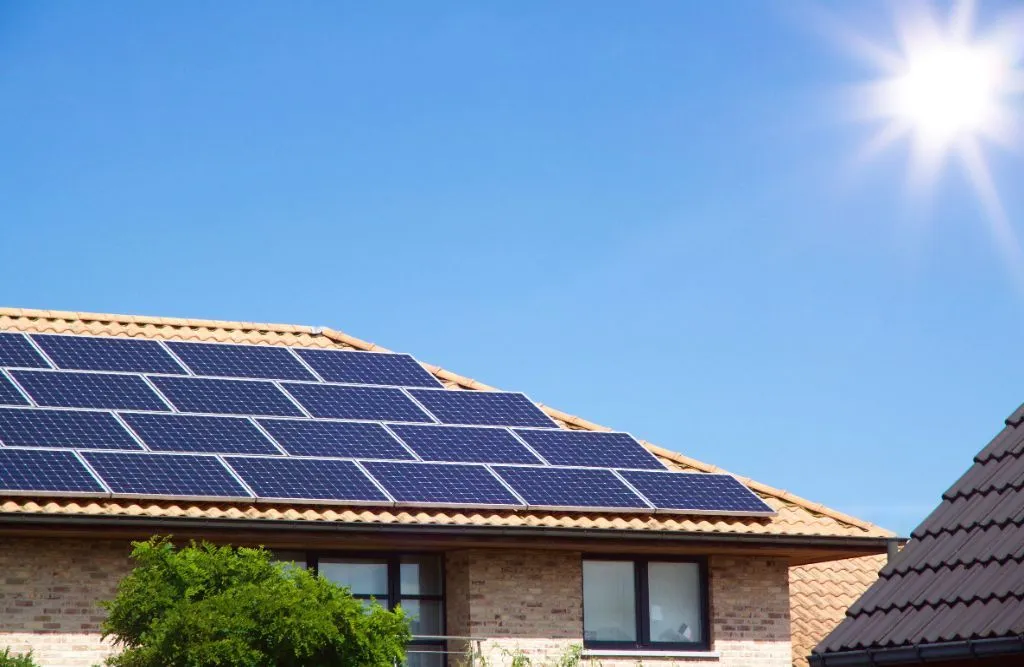
Solar energy rapidly transforms how we power our homes and commercial buildings, contributing to a more sustainable future. Households and small commercial businesses can use rooftop solar panels or solar tiles to reduce climate change.
Larger commercial facilities can opt for ground-mounted solar farms for on-site electricity generation. It’s particularly beneficial for energy-intensive businesses since it will even enhance the environmental impact of solar energy. There are many ways large businesses can achieve eco-friendly power production. Solar energy is one of them.
Many local governors often link renewable energy and climate change, so they provide many incentives to encourage solar installation in those sectors. You can apply for a tax credit or rebate, use net metering policies, and other stimuli they may provide.
Government Support of Solar Panels and Climate Change in the U.S.
As of 2024, there are numerous government incentives for solar energy on federal and local levels. The initial Investment Tax Credit (ITC) is one of the most widely known options. It lowers federal income taxes for the cost of installing the new system. The government promotes those incentives to make solar power production attractive to end users, as eco-friendly electricity can reduce climate change.
Currently, the ITC rate is 30%, lasting until December 2032. After that, it will lower to 26% in 2033 and 22% in 2034. Unless renewed, there will be no solar credit after 2035.
You can also look up various DOE grants for climate change and solar energy businesses that support solar research, development, demonstration, and workforce training. Those incentives may lower the initial investment even more, so you will be able to witness the environmental impact of solar energy in your life.
We recommend you also research local tax credits. Many states offer additional incentives beyond the federal ITC to reduce climate change even more. Usually, local tax credits range from 5% to 35%. Research the netting possibility in your area, as some counties and grid power providers offer compensation for the energy you send back to the grid.
Possible Challenges of Solar Energy and Climate Change
As a society, we face challenges on the eco-friendly path, such as grid integration issues in certain regions. Effectively connecting variable renewable sources to the grid demands flexible energy management systems and robust state and local laws.
Another possible issue is the land usage concerns. Large-scale solar farms can take up plenty of space, raising concerns about land use and environmental impact. While this type of eco-friendly electricity production can reduce climate change, it takes the place that can be utilized by plant or tree plantations.
That’s why we will face many discussions about responsible planning and integration with existing infrastructure. If we don’t discuss land usage, solar field over-expansion may annihilate the positive environmental impact of solar energy.
The third major concern is end-of-life management. Any tech eventually deteriorates and gets changed by more sustainable solutions. We can’t put solar panels on the landfill as it will wipe out all their previous benefits. That’s why federal and local governments should prescribe new recycling norms to reduce climate change.
The Positive Future of Solar Energy
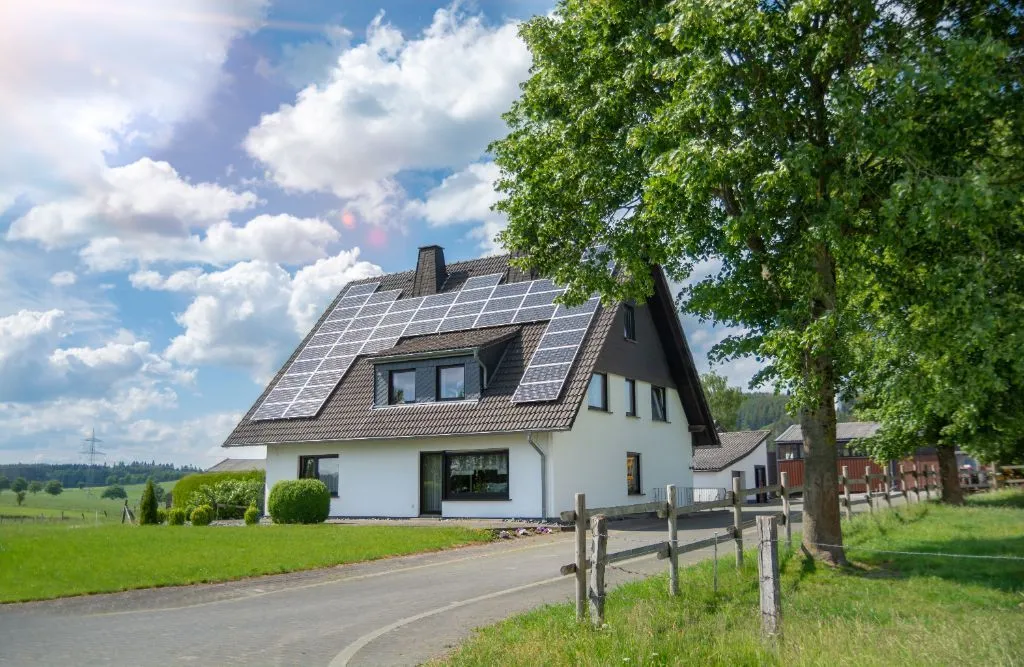
Despite all the challenges, the future of solar energy looks promising. With advancements in technology, growing demand, and increasing environmental awareness, we see how it reduces climate change year by year.
Research in thin-film solar technologies and building-integrated photovoltaics (BIPV) is paving the way for integrating solar panels seamlessly into buildings and infrastructure. Tesla’s Solar Roof is one of the examples of future solar systems that can reduce climate change. A certified installer team replaces your old roof with tiny solar shingles that produce eco-friendly energy.
Modern battery technologies enable the storage of excess energy for nighttime use, reducing reliance on the grid and minimizing the need for fossil fuel energy to power homes. This growing independence may eventually lead to fully electricity-independent communities and thus, reduce climate change.
Governments worldwide are increasingly adopting policies like renewable energy targets and tax incentives to boost solar adoption, fostering job growth in sustainable sectors and supporting the economic development of innovative regions.
The shift from fossil fuels to solar will lead to cleaner air and reduced health problems associated with air pollution. Considering the constant popularity of electric cars and the fossil fuel car ban, cities are gradually chipping away at old energy production methods.
Humanity is taking small steps towards an eco-friendly future, with green electricity production serving as a key strategy to reduce climate change in residential, business, and industrial settings.


